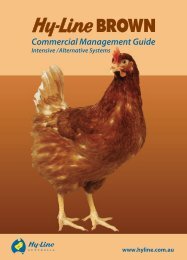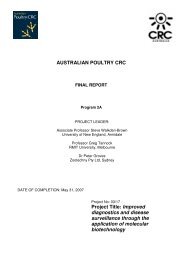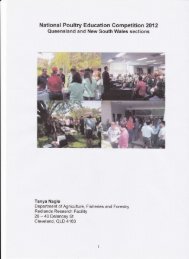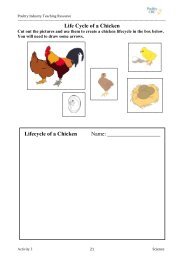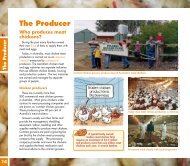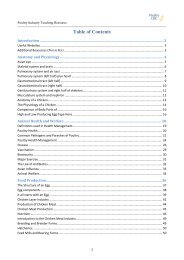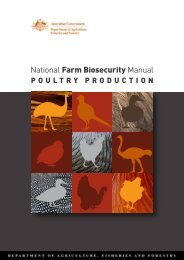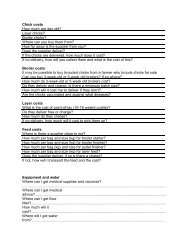You also want an ePaper? Increase the reach of your titles
YUMPU automatically turns print PDFs into web optimized ePapers that Google loves.
2.5.3 Feed preparationAll treatments were based on the same formulation within a diet, with differing levels and methods ofwheat processing being the only difference between dietary treatments. The formulations of the prestarter,starter, grower and finisher rations were contemporary commercial feeds, the composition ofwhich is not able to be published due to their commercial nature. The diets were wheat/soy based,with animal protein, vitamin and mineral premix, xylanase and an anticoccidial compound added tomeet the nutritional and health requirements of the birds. Four formulations were used (pre-starter,starter, grower and finisher) and fed depending on the growth stage and requirements of the birds atthat stage.All diets were processed at the Bartter Enterprises Pty. Ltd. feed processing site located nearHanwood; used exclusively for Bartter‟s breeder and broiler feed manufacture in the Riverina districtof NSW. The same batch of wheat was used for all diet treatments within each diet (pre-starter,starter, grower or finisher).Hammer-milled grain was processed through a computer-controlled, variable speed and flow ratehammer-mill, with a 8-10 tonne.hr -1 capacity using a 3.2mm screen. Roller-milled grain wasprocessed through a commercial roller-mill, with flow rate and roller pressure adjusted manually byhopper chute aperture and roller spacing adjustments. Milled grain particle sizes were maintainedthroughout the experiment – from starter through to finisher – for each treatment.Wheat for treatments 1 and 2 was milled through a 3.2mm screen fitted to the hammer-mill, as iscommercial practice. Treatment 3 utilised wheat from the hammer-mill, with the screen removed, andthe flow rate adjusted until the desired texture was achieved (35% flow rate). This treatment‟s grainwas an intermediate particle size between the coarse roller-milled (treatment 6), and the 3.2 mmhammer-milled wheat. The coarse hammer-milled wheat for treatment 4, was achieved by passinggrain through the hammer-mill with no screen, at a flow rate of 55 %.The wheat for the remaining three treatments (5, 6 and 7) was processed to some degree using theroller-mill. Treatment 5 grain was rolled to an intermediate particle size by adjusting the rollers to bevery close to each other; increasing the pressure on the rollers when grain was passed through the mill,and restricting the flow of grain to maximise the crushing of grain in the mill. This was done toachieve an equivalent particle size to the intermediate hammer-milled grain. The same process wasrepeated, with less pressure exerted on the rollers by widening the between roller space fractionally,but again minimising the flow of grains through the mill. This created an equivalent texture to that ofthe coarse hammer-milled grain. Grain for the final treatment was again passed through the rollermill,with the minimum of pressure and maximum flow rate exerted on the grain. This processallowed the grain to be stressed enough to cause one or more small fissures in the grain, but notenough to crush the grain into pieces.Portioning and mixing of all feed ingredients was automated using a computer system, directed andmonitored by the feed plant staff. After mixing to the prescribed formulation, the diets wereconditioned, then pelleted through a 3 mm pellet die fitted to a 38 t.hr -1 capacity steam pelleter, with aminimum draw of 200A, and a maximum draw of 575A. The energy output from the pelleter, andconditioner temperature were measured and recorded for each diet.2.5.4 Analytical proceduresParticle sizes of feed, milled grain and duodenal digestaFeed and grain particle size measurements for feeds/grain used in Experiment One, were conductedusing LASER diffraction (Mastersizer 2000, with Sirocco 2000A attachment for dispersion of dryparticulate samples, Malvern Instruments Ltd., U.K.). The Mastersizer equipment was computer13



